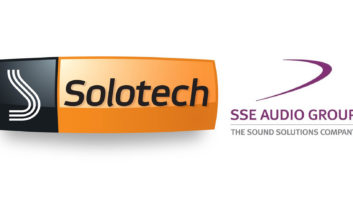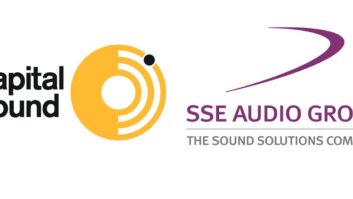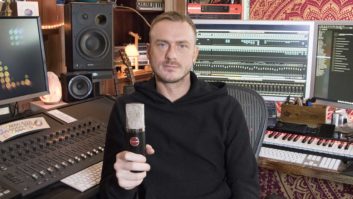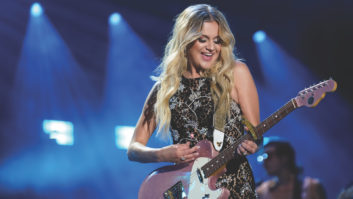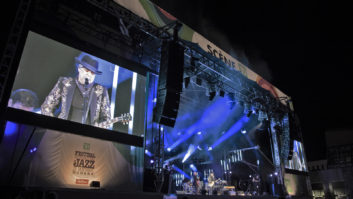SSE Audio Group won for Best Sound at the UK’s Festival Supplier Awards for the second consecutive year at the end of January 2016, almost exactly four decades after the company officially launched in Nottingham, England. The award, for SSE’s 2015 Reading Festival production, was just the latest in a long list of honors recognizing the company’s achievements in not only professional audio but also business over the years.
Full disclosure: I first met company founders, John and Heather Penn, in 1977 when I was booking local bands at college in Nottingham and needed a PA. In 1980, I answered an ad and, for the next four years, went to work at their warehouse located opposite the famed Raleigh bicycle factory, and on the road. The company’s main accounts at that time included doo-wop chart-toppers Darts plus the Undertones and Buzzcocks.
In 1984, SSE Hire relocated to share a space with Bob Doyle’s Texserv sound company in Birmingham, subsequently attracting clients such as UB40, Simply Red, AC/DC and Metallica, and, in 2003, moved into a 35,000-square-foot facility in nearby Redditch. SSE Audio Group now encompasses separate rental, sales, installation, manufacturing and stage riser divisions, and has also acquired a number of companies, including Melpomen (and its Mes Eclairages lighting division) in France and Canegreen in London. The 2013 acquisition of Wigwam Acoustics, near Manchester, created the UK’s largest rental, sales and installation organization, operating from seven locations throughout England and France.
SSE’s festival history, however, began with Glastonbury in 1979, for which the company built a load of Turbosound speakers. But the big break came 10 years later, when the company was awarded the contract for the three-day Reading Festival by promoter Vince Power and his Mean Fiddler organization, replacing the previous long-running production provider, Entec.
“We realized we had to be super serious, because we had a point to prove,” says John Penn, the SSE Audio Group’s managing director. The long-running festival had been using side-by-side stages, switching between them for successive acts. “People used to accept that bands ran late and it would overrun,” says Penn, also noting that PA companies at the time typically treated any festival as just another gig, only outdoors.
Penn, Doyle (then SSE’s sales manager) and Chris Beale, a former client who was running the rental business, put their heads together to devise a system that could meet the desired 15-minute changeover times and adhere to the strict noise restrictions (100 dB average, peaking at no more than 105 dB) imposed by the license for the site, which accommodated 30,000 and was surrounded by houses. The resultant design included a newly-acquired Electro-Voice MT-4 speaker system, tilted downward, with two 40-input TAC Scorpion desks flip-flopping between acts and a 42-input TAC SR9000 for the headliners—New Order, the Pogues and the Mission—feeding into a TAC 10/4/2 “master” desk.
With the success of the 1989 Reading Festival, SSE was awarded Power’s traditional music Fleadh (pronounced “flah”—Irish for festival), going on to dominate the UK festival scene at both indoor and outdoor venues in the decades since.
Already in 2016, SSE Audio Group has provided sound production at MTV Crashes Coventry, Country 2 Country at London’s O2, Download at Donington Park, Blenheim Palace’s Nocturne Live and the revived Isle of Wight Festival, with T in the Park, Wireless and the now twin Reading and Leeds Festivals, plus numerous others, to come.
“In the middle of May, we prepped Flip-Flop A,” says Penn. “That’s two Avid Profiles, two Yamaha CL5s and all of the interfaces. That stays together right through the summer. You can split it if you’re doing a small gig with single desks if you need to. Then we put together Flip-Flop B; that did the second stage at Download.
“Then we’ve got C and D that come and go and get split up and used elsewhere,” he continues, such as the 120-channel control package SSE is supplying to Capitol Sound in London for Stevie Wonder’s Hyde Park appearance. “We’ve got a standard design and a standard way that they go together. The only difference is that C and D will use [Yamaha] PM5Ds at monitors because we’ve got a limited stock of CL5s.” The only other variation, he says, is the choice of speaker system, which depends on factors such as the size and shape of the field or venue.
“We have a bunch of crews on retainer and they run through the whole summer. By assembling a team that knows what they’re doing, you can split the team up and still have guys with experience putting it all together.”
Because the same crew uses the same gear from festival to festival, they constantly stay on top of cleaning and repairs, he says. “It’s a well-oiled machine. When the gear comes back, every box and part is tested, every piece of gear cleaned. We got out of Download at 5 a.m. and by 10 on Monday night, the gear had been loaded onto the trucks to do the Stone Roses in Manchester. The warehouse is a military operation.”
As part of its festival work, SSE invented and refined the Skyhook in the late 80s/early 90s to hang delays.

Apart from losing Reading for 2009, SSE has provided sound at the festival since 1989. The company got the festival back in 2010 after 2009’s provider met the noise requirement at the expense of a great audience experience, says Penn.
“In 2009, we bought a L-Acoustics K1 system. Each year, as the K product has been improved, we’ve made incremental improvements [at Reading], with the addition of Kara, and improvements in delay control. Last year was the first year where all the delays were K2, the mains were K1 and side hangs were K1/2. The ability to mix them makes a huge difference,” he says.
Miles Hillyard, SSE’s senior project manager, spent time on simulation models prior to the 2015 festival. “I walked up the field during Mumford & Sons,” Penn recalls. “As soon as I got to the burger vans, the sound fell away, really quickly. The highs drop off first, of course. And by flying the bass, so you don’t couple onto the ground, you don’t get the same LF extension over the distance.”
The next night, Metallica’s “Big Mick” Hughes had the system peaking at 106 dB, Penn reports. Vanguardia Consulting, who have been officially monitoring noise levels at live events around the UK for licensees for over two decades, were using a new distributed measurement system, which helped, he says. “Multiple measurements came to a hub in real time and you could see it at front of house. The system techs could, for example, put a 7 dB notch in at 65 Hz and boost it at 69 Hz; you don’t hear it, but it tweaks it enough” to stay below the measured threshold.
“When it was at its loudest, we were 0.1 dB under the limit on the 15-minute LEQ. Under is under—we didn’t break the license. And the promoter, Melvin Benn, said that Metallica’s was the best festival sound he had ever heard.”
SSE had purchased a TEF measurement set and TOA Satori digital crossover in 1992, at Beale’s insistence, says Penn, at a time when everyone else was standardized on Klark Teknik analyzers and processors. The TEF’s data storage abilities enabled SSE to contest a broken license in court after the first Phoenix Festival near Stratford-upon-Avon, he recalls.
Indeed, SSE has a history of innovation. It was also at Phoenix that SSE introduced the first “shout” system, cobbling together early versions of an IEM pack, a radio transmitter and a headset mic to enable crew on stage to wirelessly conduct line checks before the next act. “Now everybody uses the bespoke systems that you can buy, but we were the first to do it and we called it the ‘shout system,’ which became the generic name,” he says.
“We invented the ‘skyhook,’ the very first freestanding delay tower, which we took out on Simply Red,” he continues. Designed by Beale, who had an engineering background, the delay tower had a flat base and a narrow mast that didn’t obstruct sightlines, replacing traditional, bulky scaffolding. After seeing U2’s 1993 Roundhay Park show in Leeds, for which FOH engineer Joe O’Herlihy borrowed four of SSE’s skyhooks, Joe Ravitch from Clair introduced the design in the US, Penn recalls.
“We made festivals our specialist subject, perhaps to the detriment of other things,” he believes. “Some bands didn’t like us; they would get better service from other companies, because they would be taken care of as if it was their gig. But we were neutral; we had the understanding that you weren’t working for the band—you were working for the promoter. We geared up to not favor any one band.”
Now, he says, “We’re considered to be the safe pair of hands. Whether you like us or not, you walk into a gig that we’re doing and you know exactly what you’re getting and that it’s all going to work.”
